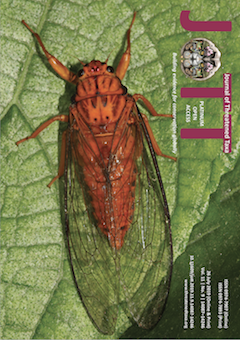Greater One-horned Rhinoceros Rhinoceros unicornis (Mammalia: Perissodactyla: Rhinocerotidae) population census in the Rajiv Gandhi Orang National Park, Assam, India
DOI:
https://doi.org/10.11609/jott.4415.11.9.14187-14193Keywords:
Complete-count, direct count, habitat management, Indian Rhino, trendAbstract
The complete-count of rhino or rhino census is an integral part of conservation and management of wild rhino-bearing areas of Assam. The direct count of rhinos in their wild habitat continues as the accepted method of determining rhino population. As a part of the periodic process, the Rajiv Gandhi Orang National Park (RGONP) organized a one-day direct rhino count on 2 April 2018. The results showed 1% increment of the population after a gap of six years. Such slow increment is considered to be a matter of concern. More research is necessary for better understanding of the population dynamics and identification of factors for better management of rhino population at RGONP.
References
Barua, M. (1998). Pobitora Wildlife Sanctuary. Zoo’s Print 13(4): 9–1.
Bhatta, R. (2011). Ecology and Conservation of Great Indian One Horned Rhino Rhinoceros unicornis in Pobitora Wildlife Sanctuary, Assam, India, PhD Thesis, Gauhati University, 227pp.
Borthakur, U., P. Das, A. Talukdar & B. Talukdar (2016). Non-invasive genetic census of Greater one horned rhinoceros (Rhinoceros unicornis) in Gorumara National Park, India: a pilot study for population estimation. Oryx 50(3): 489–494. https://doi.org/10.1017/S0030605314001161
Daniel, J.C. (1967). The Point Calemere Sanctuary, Madras State. Journal of the Bombay Natural Histroy Society 64(3): 512–523.
Debroy, S. (1986). Fire in tall grassland habitats of Assam. The Indian Forester 112(10): 414–418.
DNPWC (2009). The Status and Distribution of the Greater One Horned Rhino in Nepal. Department of National Parks and Wildlife Conservation, Kathmandu, Nepal, XV+72pp.
Davider, E.R.C. (1978). Distribution and status of the Nilgiri Tahr Hemitragus hylocrius 1975–78. Journal of the Bombay Natural Histroy Society 75(3): 815–844.
Dutta, D.K., A. Sharma, R. Mahanta & A. Swargowari (2017). Behaviour of post released translocated Greater One Horned Rhinoceros Rhinoceros unicornis at Manas National Park, Assam, India. Pachyderm (58): 58–66.
Gopal, R. (2012). Fundamentals of Wildlife Management. Nataraj Publisher, New Delhi, 1288pp.
Assam Forest Department (2014). White Paper on Wildlife Conservation in Assam, Department of Environment and Forests, Government of Assam, 109pp.
Hazarika, B.C. (2007). Studies on the Eco-Behavioural Aspects of Great Indian One-Horned Rhino (Rhinoceros unicornis Lin) in Orang National Park, India. PhD Thesis, Gauhati University, 270pp.
IUCN AsRSG (2009). The Greater One Horned Rhinoceros Monitoring Instructos Training Manual. International Union for Nature Conservation and Asian Rhino Sepcialist Group, 108pp.
Lahan, P. & S.N. Sonowal (1973). Kaziranga Wildlife Sanctuary, Assam, Journal of Journal of the Bombay Natural Histroy Society 70(2): 245–278.
Lahkar, P.B., K.B. Talukdar & P. Sarma (2011). Invasive species in grassland habitat and ecological threat to Greater One Horned Rhino (Rhinoceros unicornis). Pachyderm 49: 33–39.
Laurie, W.A. (1978). The Ecology and Behaviour of the Greater One-Horned Rhinoceros. PhD Dissertation, Cambridge University, Cambridge, UK, 486pp.
Mukherjee, S. & S. Sengupta (1999). Census of Great Indian One Horned Rhinoceros at Jaldapara Wildife Sanctuary, Cooch Behar Forest Division, West Bengal, India. Tiger Paper 26(4): 18–21.
Nair, P.V. & M. Gadgil (1980). The status and distribution of elephant populations of Karnataka. Journal of the Bombay Natural Histroy Society 75(suppl.): 1000–1016.
Nair, S.S. (1976). A population survey and observation on the behaviour of the blackbuck in the Point Calemere Sanctuary Tamilnadu. Journal of the Bombay Natural Histroy Society 73(2): 304–310.
Overton, W.S. (1971) Estimating the numbers of animals in wildlife populations, pp3–7. In: Giles, R.H. (Ed.) Wildlife Management Techniques, 3rd Edition. The Wildlife Society, Washington D.C., 633pp.
Patton, F.J. (2007). The use of Individual identification in conservation management of Black Rhinoceros (Diceros bicornis). PhD Thesis. Manchester Metropolitan University, UK, 218pp.
Sarma, K.P., S.B. Mipun, K.B. Talukdar, H. Singh, K.A. Basumatary, K.A. Das, A. Sarkar & B.C. Hazarika (2012). Assessment of Habitat Utilization pattern of rhinos (Rhinoceros unicornis) in Orang National Park, Assam, India. Pachyderm 51: 38–44.
Schaller, G.B. (1967). The Deer and the Tiger-A Study of Wildlife in India. The University of Chicago Press, Chicago & London, 384pp.
Singh, V.B. (1978). The elephant in U.P. (India): a resurvey of its status after 10 years. Journal of the Bombay Natural Histroy Society 75(1): 71–82.
Subedi, N., S. Jnawali, M. Dhakal, N. Pradhan, B. Lamichhane, S. Malla & Y. Jhala (2013). Population status, structure and distribution of the Greater one-horned Rhinoceros, Rhinoceros unicornis in Nepal. Oryx 47(3): 352–360. https://doi.org/10.1017/S0030605313000562
Published
Issue
Section
License
Authors own the copyright to the articles published in JoTT. This is indicated explicitly in each publication. The authors grant permission to the publisher Wildlife Information Liaison Development (WILD) Society to publish the article in the Journal of Threatened Taxa. The authors recognize WILD as the original publisher, and to sell hard copies of the Journal and article to any buyer. JoTT is registered under the Creative Commons Attribution 4.0 International License (CC BY), which allows authors to retain copyright ownership. Under this license the authors allow anyone to download, cite, use the data, modify, reprint, copy and distribute provided the authors and source of publication are credited through appropriate citations (e.g., Son et al. (2016). Bats (Mammalia: Chiroptera) of the southeastern Truong Son Mountains, Quang Ngai Province, Vietnam. Journal of Threatened Taxa 8(7): 8953–8969. https://doi.org/10.11609/jott.2785.8.7.8953-8969). Users of the data do not require specific permission from the authors or the publisher.





